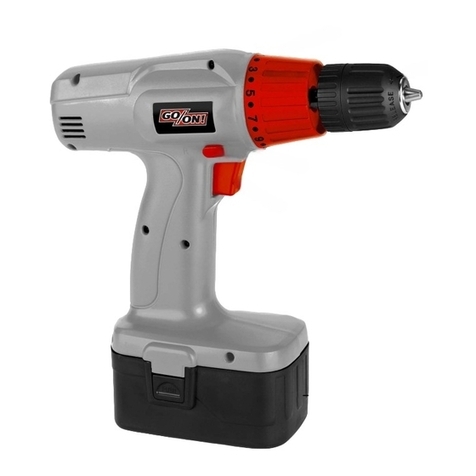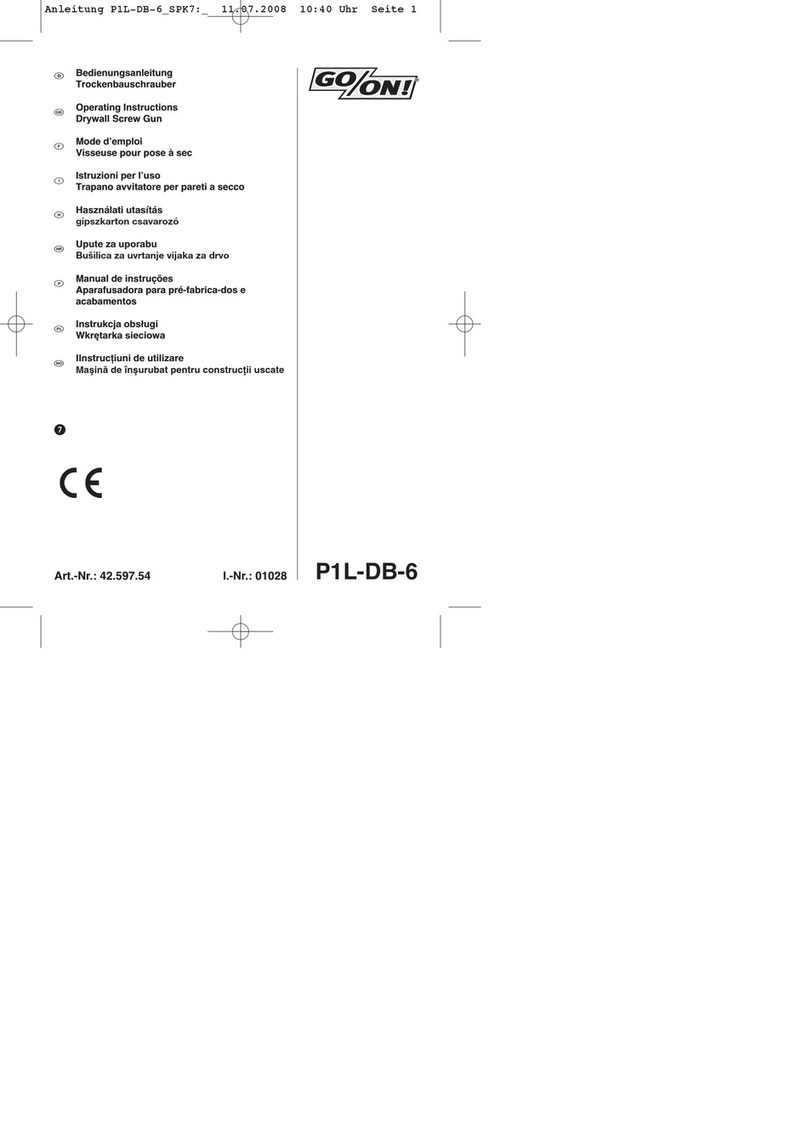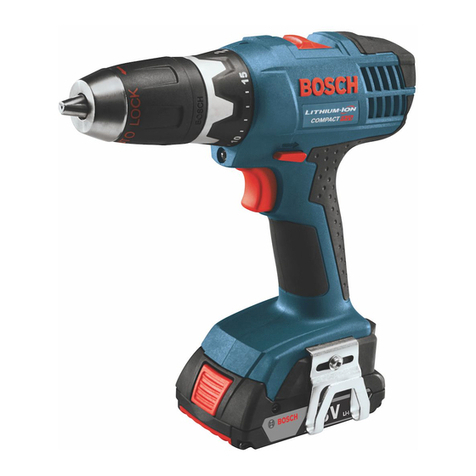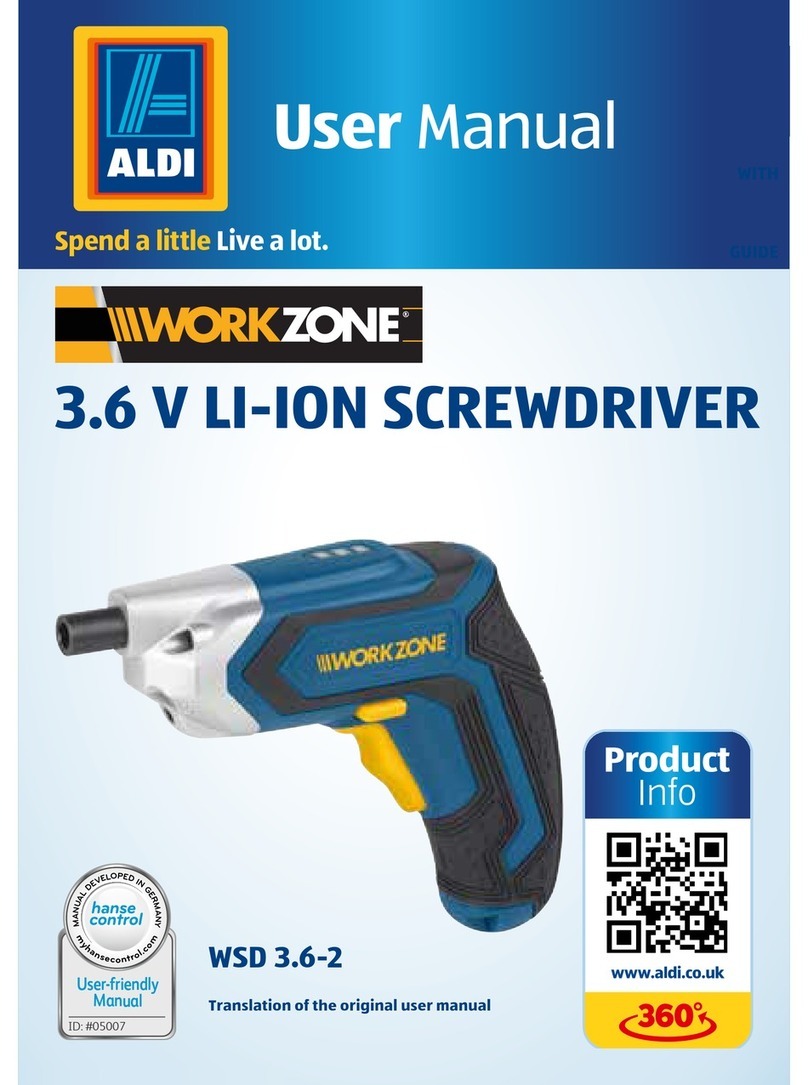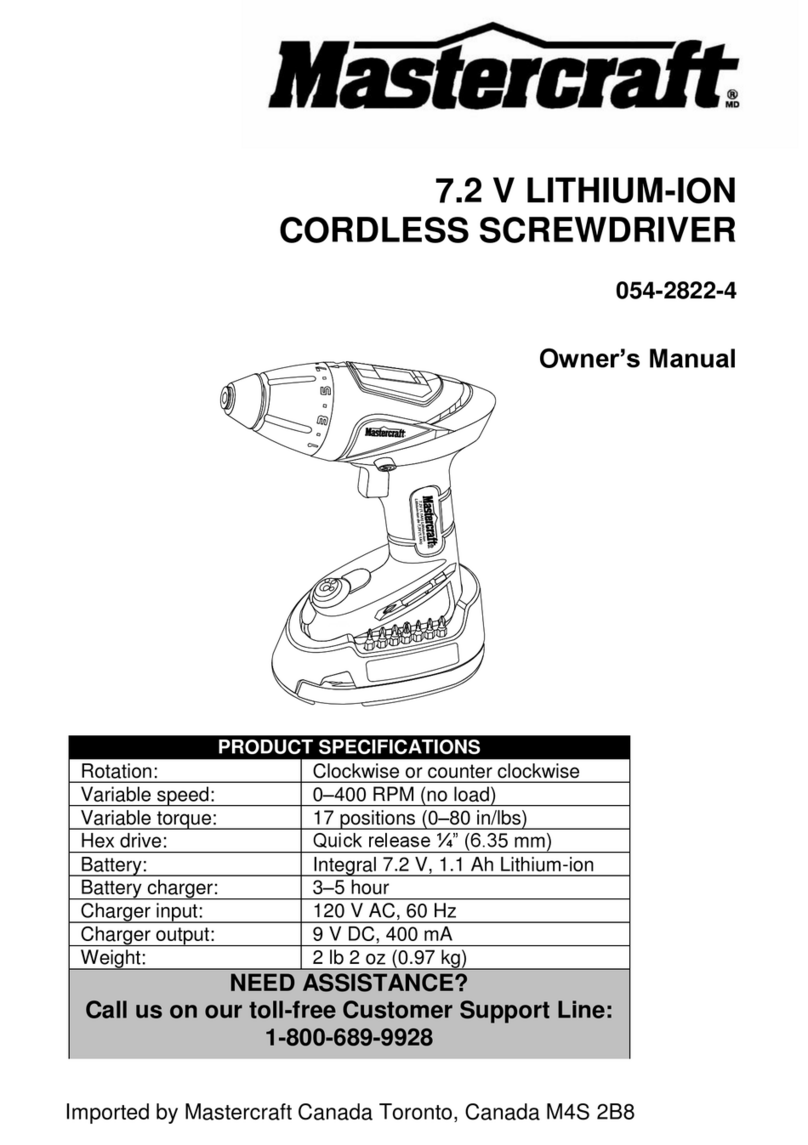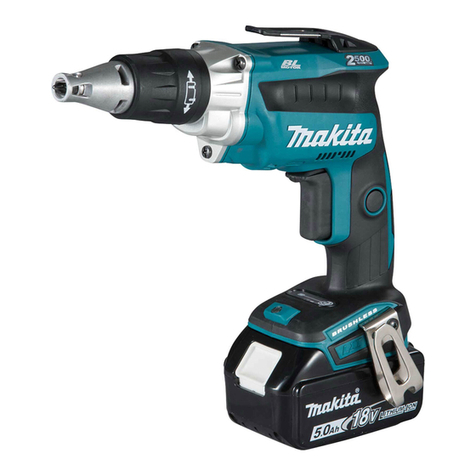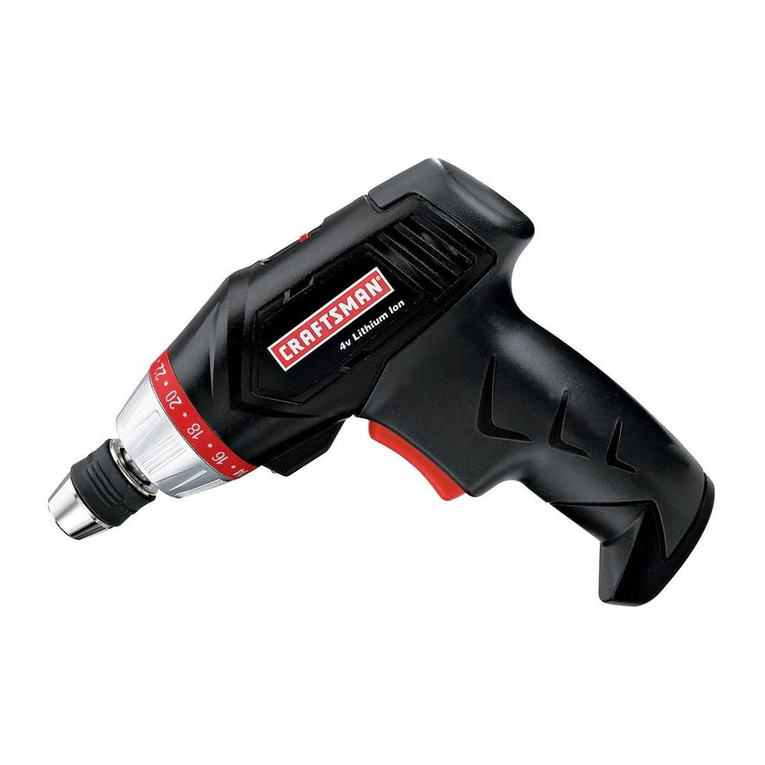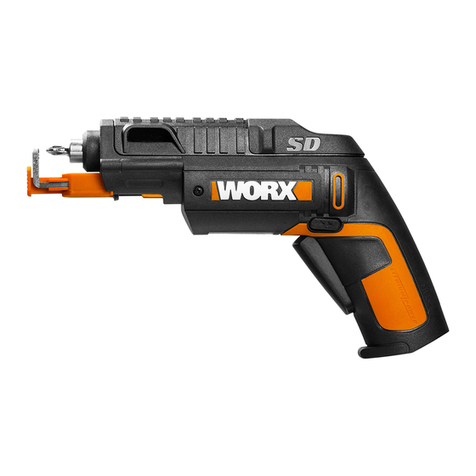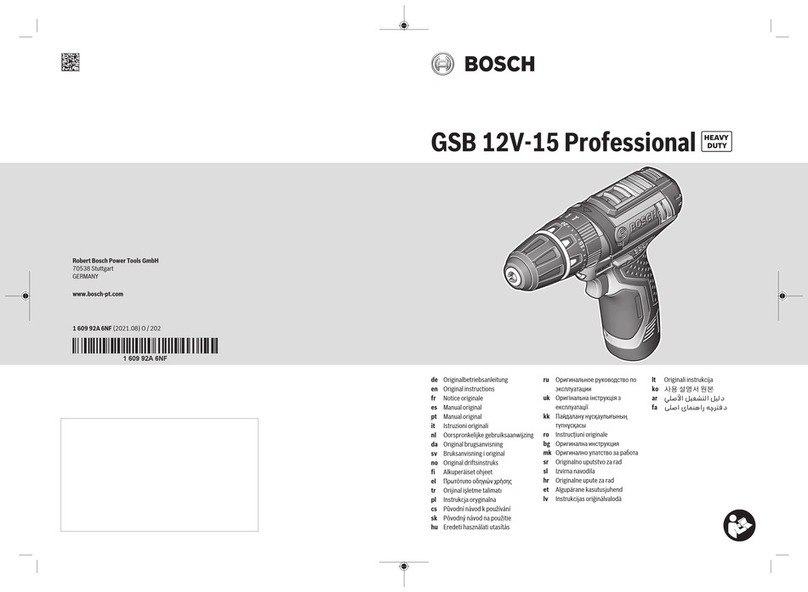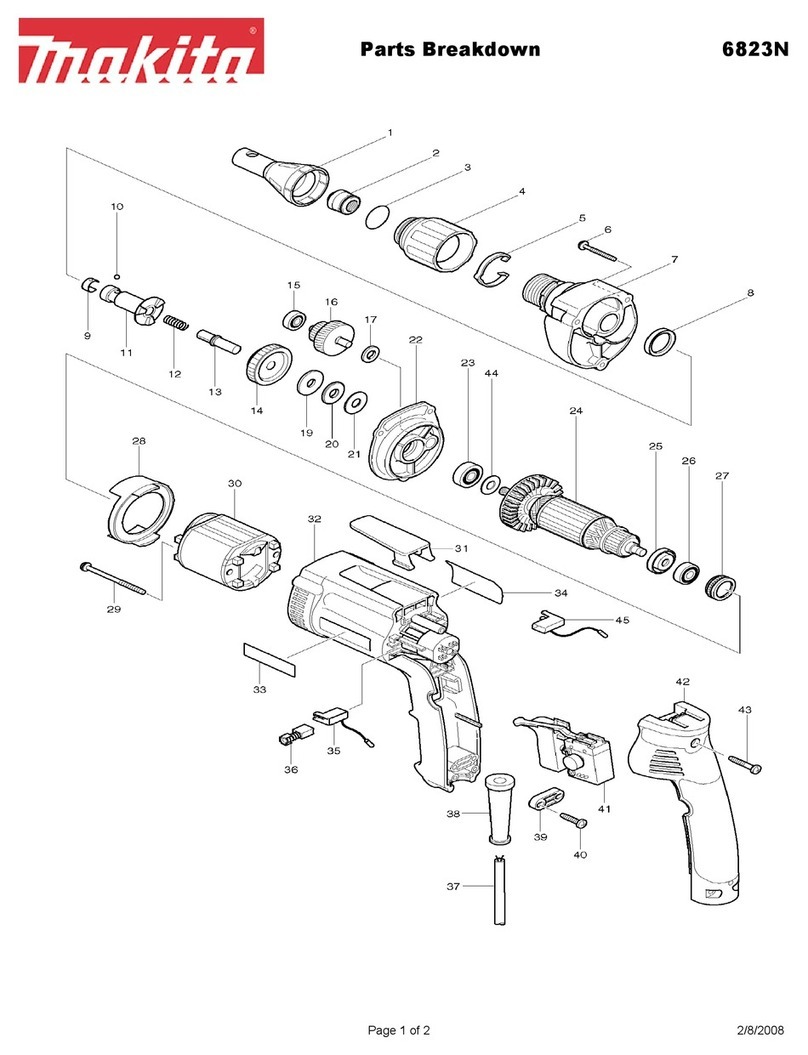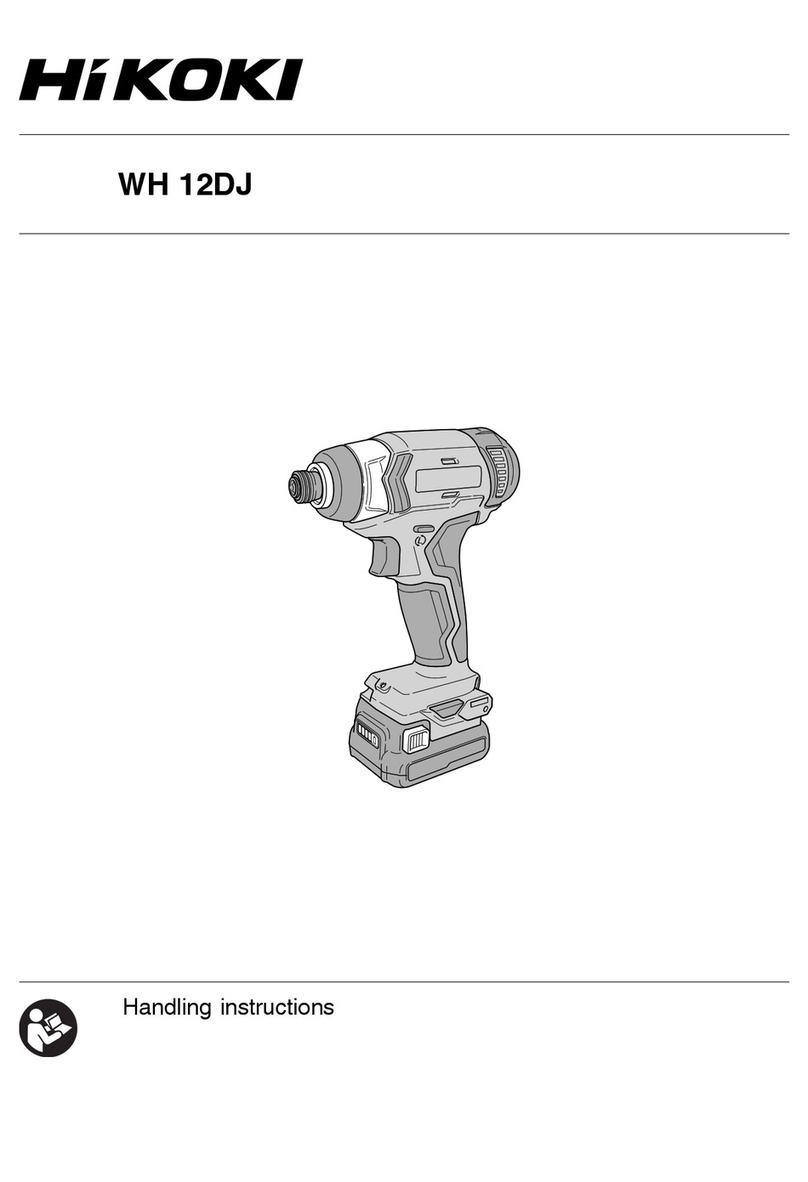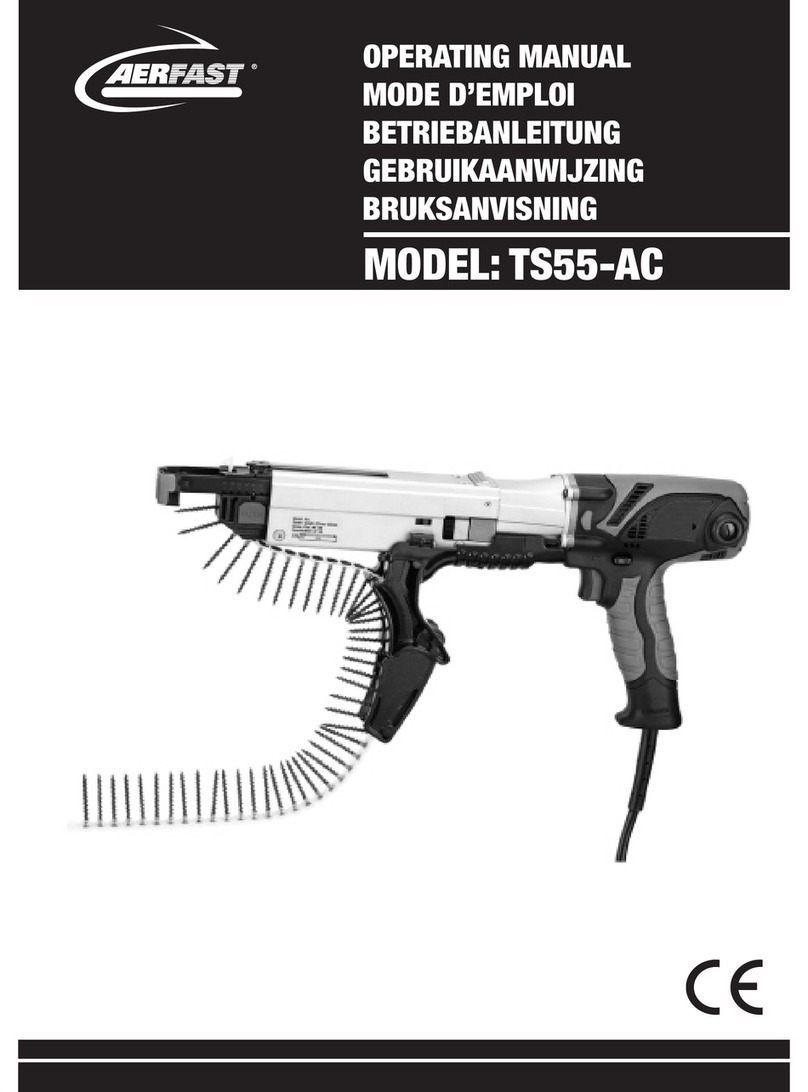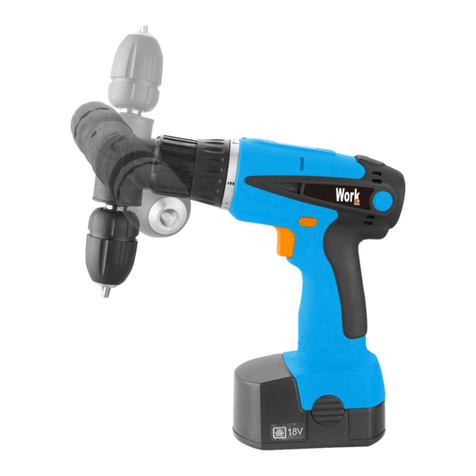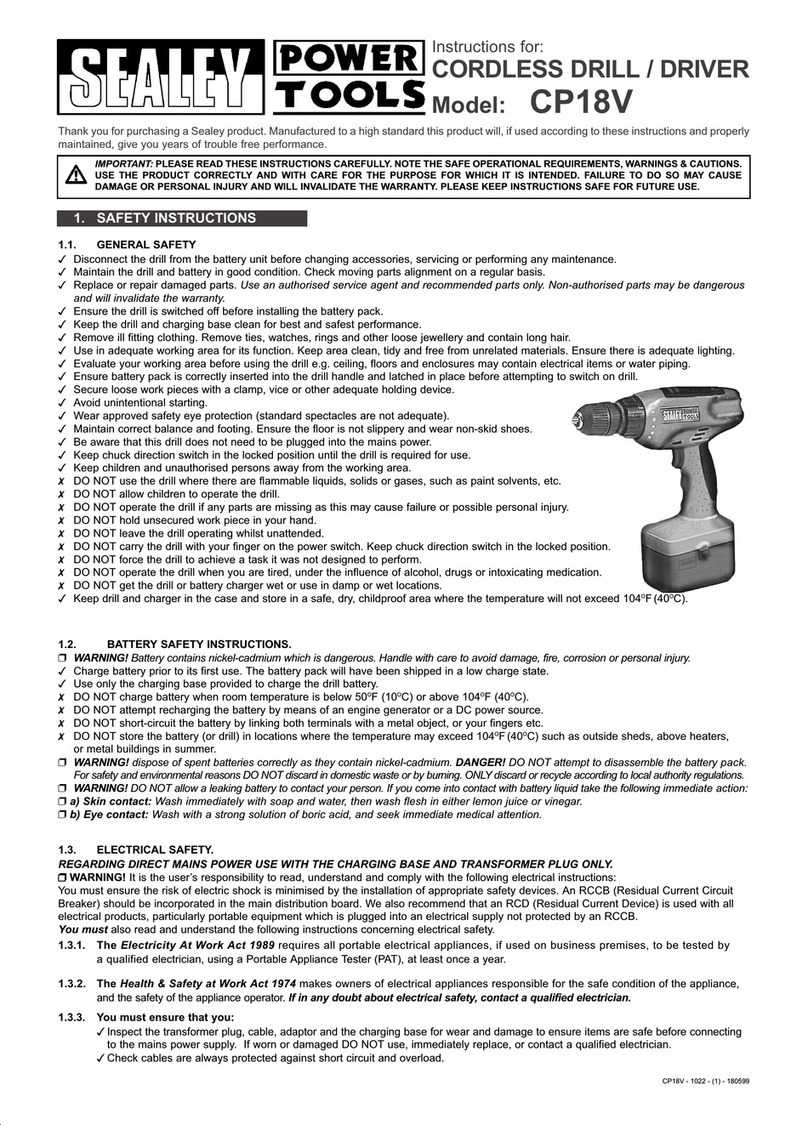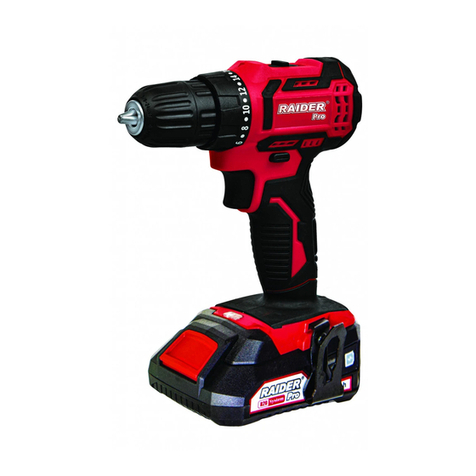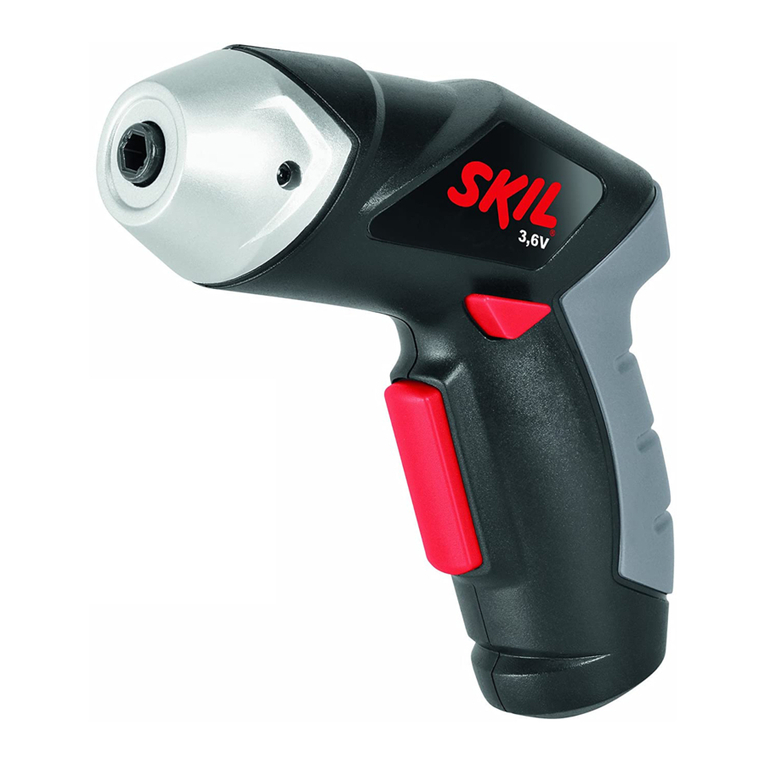Go-On PLCD-01-18 V User manual

Art.-Nr.: 45.130.92 I.-Nr.: 01028 PLCD-01-18 V
kBedienungsanleitung
Akku-Bohrschrauber
tOperating Instructions
Cordless Drill
pMode dʼemploi
Perceuse-visseuse sans fil
CIstruzioni per lʼuso
Trapano avvitatore a batteria
AHasználati utasítás
Akku-fúrócsavarozó
BUpute za uporabu
Akumulatorska bušilica
OManual de instruções
Berbequim-aparafusador sem fio
PInstrukcja obsługi
Wiertarko-wkrętarka akumulatorowa
QInstrucţiuni de utilizare
Maşină de găurit şi înşurubat cu acumulator
Anleitung_PLCD_01_18V_SPK7:_ 14.07.2008 11:59 Uhr Seite 1

2
1
213
78
2 3
5
4
1.
2.
5
6
8
1.
7
5
a
1.
2.
6
Anleitung_PLCD_01_18V_SPK7:_ 14.07.2008 11:59 Uhr Seite 2

3
4
1
5
4
6
a
3
2
Anleitung_PLCD_01_18V_SPK7:_ 14.07.2008 11:59 Uhr Seite 3

4
“WARNUNG - Zur Verringerung des Verletzungsrisikos Bedienungsanleitung lesen”
Tragen Sie einen Gehörschutz.
Die Einwirkung von Lärm kann Gehörverlust bewirken.
Tragen Sie eine Staubschutzmaske.
Beim Bearbeiten von Holz und anderer Materialien kann gesundheitsschädlicher Staub
entstehen. Asbesthaltiges Material darf nicht bearbeitet werden!
Tragen Sie eine Schutzbrille.
Während der Arbeit entstehende Funken oder aus dem Gerät heraustretende Splitter, Späne
und Stäube können Sichtverlust bewirken.
D
Anleitung_PLCD_01_18V_SPK7:_ 14.07.2008 11:59 Uhr Seite 4

5
D
Achtung!
Beim Benutzen von Geräten müssen einige
Sicherheitsvorkehrungen eingehalten werden, um
Verletzungen und Schäden zu verhindern. Lesen Sie
diese Bedienungsanleitung / Sicherheitshinweise
deshalb sorgfältig durch. Bewahren Sie diese gut auf,
damit Ihnen die Informationen jederzeit zur
Verfügung stehen. Falls Sie das Gerät an andere
Personen übergeben sollten, händigen Sie diese
Bedienungsanleitung / Sicherheitshinweise bitte mit
aus. Wir übernehmen keine Haftung für Unfälle oder
Schäden, die durch Nichtbeachten dieser Anleitung
und den Sicherheitshinweisen entstehen.
1. Sicherheitshinweise
Die entsprechenden Sicherheitshinweise finden Sie
im beiliegenden Heftchen!
WARNUNG
Lesen Sie alle Sicherheitshinweise und
Anweisungen. Versäumnisse bei der Einhaltung der
Sicherheitshinweise und Anweisungen können
elektrischen Schlag, Brand und/oder schwere
Verletzungen verursachen zur Folge haben.
Bewahren Sie alle Sicherheitshinweise und
Anweisungen für die Zukunft auf.
2. Gerätebeschreibung (Abb. 1)
1. Drehmomenteinstellung
2. Schnellspannbohrfutter
3. Drehrichtungsschalter
4. Ein-/ Ausschalter
5. Akku
6. Ladegerät
7. Ladeadapter
8. Rasttaste
3. Bestimmungsgemäße Verwendung
Der Akku-Bohrschrauber ist geeignet zum Eindrehen
und Lösen von Schrauben, sowie zum Bohren in
Holz, Metall und Kunststoff.
Die Maschine darf nur nach ihrer Bestimmung
verwendet werden. Jede weitere darüber
hinausgehende Verwendung ist nicht
bestimmungsgemäß. Für daraus hervorgerufene
Schäden oder Verletzungen aller Art haftet der
Benutzer/Bediener und nicht der Hersteller.
Bitte beachten Sie, dass unsere Geräte
bestimmungsgemäß nicht für den gewerblichen,
handwerklichen oder industriellen Einsatz konstruiert
wurden. Wir übernehmen keine Gewährleistung,
wenn das Gerät in Gewerbe-, Handwerks- oder
Industriebetrieben sowie bei gleichzusetzenden
Tätigkeiten eingesetzt wird.
4. Technische Daten
Spannungsversorgung Motor: 18 V d.c.
Leerlauf-Drehnzahl: 0-550 min-1
Drehmomentstufen: 15+1
Rechts- Links-Lauf: ja
Spannweite Bohrfutter: max. 10 mm
Ladespannung Akku: 21 V d.c.
Ladestrom Akku: 0,4 A
Netzspannung Ladegerät: 230V~ 50Hz
Ladezeit: max. 3-5 Std.
Akkutyp: NiCd
Gewicht: 1,4 kg
Geräusch und Vibration
Die Geräusch- und Vibrationswerte wurden entspre-
chend EN 60745 ermittelt.
Schalldruckpegel LpA 63,2 dB(A)
Unsicherheit KpA 3 dB
Schallleistungspegel LWA 74,2 dB(A)
Unsicherheit KWA 3 dB
Tragen Sie einen Gehörschutz.
Die Einwirkung von Lärm kann Gehörverlust bewir-
ken.
Schwingungsgesamtwerte (Vektorsumme dreier
Richtungen) ermittelt entsprechend EN 60745.
Bohren in Metall
Schwingungsemissionswert ah≤ 2,5 m/s2
Unsicherheit K = 1,5 m/s2
Schrauben ohne Schlag
Schwingungsemissionswert ah≤ 2,5 m/s2
Unsicherheit K = 1,5 m/s2
Anleitung_PLCD_01_18V_SPK7:_ 14.07.2008 11:59 Uhr Seite 5

6
D
Achtung!
Der Schwingungswert wird sich aufgrund des Ein-
satzbereiches des Elektrowerkzeuges ändern und
kann in Ausnahmefällen über dem angegebenen
Wert liegen.
5. Vor Inbetriebnahme
Lesen Sie vor der Inbetriebnahme Ihres
Akkuschraubers unbedingt diese Hinweise:
1. Laden Sie den Akku-Pack nur mit dem
mitgelieferten Ladegerät.
2. Nur scharfe Bohrer sowie einwandfreie und
geeignete Schrauberbits verwenden.
3. Beim Bohren und Schrauben in Wänden und
Mauern diese auf verborgene Strom-, Gas- und
Wasserleitung überprüfen.
6. Bedienung
6.1 Laden des Akkus (Abb. 2-3)
1. Akku-Pack aus dem Handgriff heraus ziehen
(Bild 2), dabei die Rasttasten drücken.
2. Vergleichen Sie, ob die auf dem Typenschild
angegebene Netzspannung mit der vorhandenen
Netzspannung übereinstimmt. Stecken Sie das
Ladegerät in die Steckdose.
3. Stecken Sie den Akku-Pack in den Ladeadapter.
Die Leuchtdiode (a) signalisiert, dass der Akku-
Pack geladen wird. Während des
Ladevorgangs kann sich der Akku-Pack etwas
erwärmen, dies ist jedoch normal.
Achtung! Bei Vollladung erfolgt keine
automatische Abschaltung.
Sollte das Laden des Akku-Packs nicht möglich sein,
überprüfen Sie bitte
ob an der Steckdose die Netzspannung
vorhanden ist.
ob ein einwandfreier Kontakt an den
Ladekontakten des Ladegerätes vorhanden ist.
Sollte das Laden des Akku-Packs immer noch nicht
möglich sein, bitten wir Sie,
das Ladegerät
und den Akku-Pack
an unseren Kundendienst zu senden.
Im Interesse einer langen Lebensdauer des Akku-
Packs sollten Sie für eine rechtzeitige
Wiederaufladung des Akku-Packs sorgen. Dies ist
auf jeden Fall notwendig, wenn Sie feststellen, dass
die Leistung des Akku-Schraubers nachlässt.
Entladen Sie den Akku-Pack nie vollständig. Dies
führt zu einem Defekt des Akku-Packs!
6.2 Drehmoment-Einstellung (Abb. 4/Pos. 1)
Der Akkuschrauber ist mit einer mechanischen
Drehmomenteinstellung ausgestattet.
Das Drehmoment für eine bestimmte
Schraubengröße wird am Stellring (1) eingestellt.
Das Drehmoment ist von mehreren Faktoren
abhängig:
von der Art und Härte des zu bearbeitenden
Materials.
von der Art und der Länge der verwendeten
Schrauben.
von den Anforderungen, die an die
Schraubverbindung gestellt werden.
Das Erreichen des Drehmoments wird durch das
ratschende Ausrücken der Kupplung signalisiert.
Achtung! Stellring für das Drehmoment nur bei
Stillstand einstellen.
6.3 Bohren (Abb. 4/Pos. 1)
Zum Bohren stellen Sie den Einstellring für das
Drehmoment auf die letzte Stufe „Bohrer“. In der
Stufe Bohren ist die Rutschkupplung außer Betrieb.
Beim Bohren ist das maximale Drehmoment
verfügbar.
6.4 Drehrichtungsschalter (Abb. 5/Pos. 3)
Mit dem Schiebeschalter über dem Ein/Aus-Schalter
können Sie die Drehrichtung des Akku-Schraubers
einstellen und den Akku-Schrauber gegen
ungewolltes Einschalten sichern. Sie können
zwischen Links- und Rechtslauf wählen. Um eine
Beschädigung des Getriebes zu vermeiden, darf die
Drehrichtung nur im Stillstand umgeschaltet werden.
Befindet sich der Schiebeschalter in der
Mittelstellung, ist der Ein/Aus-Schalter blockiert.
6.5 Ein/Aus-Schalter (Abb. 5/Pos. 4)
Mit dem Ein/Aus-Schalter können Sie die Drehzahl
stufenlos steuern. Je weiter Sie den Schalter
drücken, desto höher ist die Drehzahl des
Akkuschraubers.
6.6 Werkzeugwechsel (Bild 6)
Achtung! Stellen Sie bei allen Arbeiten (z.B.
Werkzeugwechsel; Wartung; usw.) am
Akkuschrauber den Drehrichtungsschalter (3) in
Mittelstellung.
Der Akkuschrauber ist mit einem
Schnellspanbohrfutter (2) mit automatischer
Spindelarretierung ausgestattet.
Drehen Sie das Bohrfutter (2) auf.
Anleitung_PLCD_01_18V_SPK7:_ 14.07.2008 11:59 Uhr Seite 6

7
D
Die Bohrfutteröffnung (a) muss groß genug sein,
um das Werkzeug (Bohrer bzw. Schrauberbit)
aufzunehmen.
Wählen Sie das geeignete Werkzeug aus.
Schieben Sie das Werkzeug soweit wie möglich
in die Bohrfutteröffnung (a) hinein.
Drehen Sie das Bohrfutter (2) fest zu, und prüfen
Sie anschließend den festen Sitz des
Werkzeuges.
6.7 Schrauben
Verwenden Sie am besten Schrauben mit
Selbstzentrierung (z. B. Torx, Kreuzschiltz), welches
ein sicheres Arbeiten gewährleistet. Achten Sie
darauf, dass der verwendete Bit und die Schraube in
Form und Größe übereinstimmen. Nehmen Sie die
Drehmomenteinstellung, wie in der Anleitung
beschrieben, entsprechend der Schraubengröße vor.
7. Reinigung, Wartung und
Ersatzteilbestellung
Ziehen Sie vor allen Reinigungsarbeiten den
Netzstecker.
7.1 Reinigung
Halten Sie Schutzvorrichtungen, Luftschlitze und
Motorengehäuse so staub- und schmutzfrei wie
möglich. Reiben Sie das Gerät mit einem
sauberen Tuch ab oder blasen Sie es mit
Druckluft bei niedrigem Druck aus.
Wir empfehlen, dass Sie das Gerät direkt nach
jeder Benutzung reinigen.
Reinigen Sie das Gerät regelmäßig mit einem
feuchten Tuch und etwas Schmierseife.
Verwenden Sie keine Reinigungs- oder
Lösungsmittel; diese könnten die Kunststoffteile
des Gerätes angreifen. Achten Sie darauf, dass
kein Wasser in das Geräteinnere gelangen kann.
7.2 Wartung
Im Geräteinneren befinden sich keine weiteren
zu wartenden Teile.
7.3 Ersatzteilbestellung:
Bei der Ersatzteilbestellung sollten folgende
Angaben gemacht werden;
Typ des Gerätes
Artikelnummer des Gerätes
Ident-Nummer des Gerätes
Ersatzteilnummer des erforderlichen Ersatzteils
Aktuelle Preise und Infos finden Sie unter
www.isc-gmbh.info
8. Entsorgung und Wiederverwertung
Das Gerät befindet sich in einer Verpackung um
Transportschäden zu verhindern. Diese Verpackung
ist Rohstoff und ist somit wieder verwendbar oder
kann dem Rohstoffkreislauf zurückgeführt werden.
Das Gerät und dessen Zubehör bestehen aus
verschiedenen Materialien, wie z.B. Metall und
Kunststoffe. Führen Sie defekte Bauteile der
Sondermüllentsorgung zu. Fragen Sie im
Fachgeschäft oder in der Gemeindeverwaltung nach!
Anleitung_PLCD_01_18V_SPK7:_ 14.07.2008 11:59 Uhr Seite 7

“Caution - Read the operating instructions to reduce the risk of inquiry”
Wear ear-muffs.
The impact of noise can cause damage to hearing.
Wear a breathing mask.
Dust which is injurious to health can be generated when working on wood and other materials.
Never use the device to work on any materials containing asbestos!
Wear safety goggles.
Sparks generated during working or splinters, chips and dust emitted by the device can cause
loss of sight.
8
GB
Anleitung_PLCD_01_18V_SPK7:_ 14.07.2008 11:59 Uhr Seite 8

9
GB
Important!
When using equipment, a few safety precautions
must be observed to avoid injuries and damage.
Please read the complete operating manual with due
care. Keep this manual in a safe place, so that the
information is available at all times. If you give the
equipment to any other person, give them these
operating instructions as well.
We accept no liability for damage or accidents which
arise due to non-observance of these instructions
and the safety information.
1. Safety information
Please refer to the booklet included in delivery for the
safety instructions.
CAUTION!
Read all safety regulations and instructions.
Any errors made in following the safety regulations
and instructions may result in an electric shock, fire
and/or serious injury.
Keep all safety regulations and instructions in a
safe place for future use.
2. Layout (Fig. 1)
1. Torque selector
2. Quick-change drill chuck
3. Changeover switch
4. ON/OFF switch
5. Battery pack
6. Battery charger
7. Charging adapter
8. Pushlock button
3. Proper use
The cordless drill/screwdriver is designed for
tightening and undoing screws, as well as for drilling
in wood, metal and plastic.
The machine is to be used only for its prescribed
purpose. Any other use is deemed to be a case of
misuse. The user / operator and not the
manufacturer will be liable for any damage or injuries
of any kind caused as a result of this.
Please note that our equipment has not been
designed for use in commercial, trade or industrial
applications. Our warranty will be voided if the
machine is used in commercial, trade or industrial
businesses or for equivalent purposes.
4. Technical data
Voltage supply 18 V d.c.
Idling speed: 0-550 rpm
Torque settings: 15+1
Forward and reverse rotation yes
Chuck clamping width max. 10 mm
Battery charging voltage 21 V d.c.
Battery charging current 0.4 A
Mains voltage for charger 230 V ~ 50 Hz
Charging time: max. 3-5 hours
Battery type: NiCd
Weight 1.40 kg
Sound and vibration
Sound and vibration values were measured in
accordance with EN 60745.
LpA sound pressure level 63,2 dB(A)
KpA uncertainty 3 dB
LWA sound power level 74,2 dB(A)
KWA uncertainty 3 dB
Wear ear-muffs.
The impact of noise can cause damage to hearing.
Total vibration values (vector sum of three directions)
determined in accordance with EN 60745.
Drilling in concrete
Vibration emission value ah≤ 2,5 m/s2
K uncertainty = 1,5 m/s2
Screwing without hammer action
Vibration emission value ah≤ 2,5 m/s2
K uncertainty = 1,5 m/s2
Important!
The vibration value changes according to the area of
application of the electric tool and may exceed the
specified value in exceptional circumstances.
Anleitung_PLCD_01_18V_SPK7:_ 14.07.2008 11:59 Uhr Seite 9

5. Before starting the equipment
Be sure to read the following information before you
use your cordless screwdriver for the first time:
1. Charge the battery pack only with the charger
supplied.
2. Only ever use sharp drill bits and screwdriver bits
which are suitable for the purpose and in
faultless condition.
3. Always check for concealed electric cables and
gas and water pipes when drilling and screwing
in walls.
6. Operation
6.1 Charging the battery pack (Fig. 2/3)
1. Take the rechargeable battery pack out of the
handle (Fig. 2), pressing the pushlock buttons at
the side to do so.
2. Check that your mains voltage is the same as that
marked on the rating plate of the battery charger.
Plug the battery charger in the socket.
3. Plug the battery pack into the charging adapter.
The LED (a) will come on to indicate that the
battery pack is being charged. The temperature
of the battery pack may rise slightly during the
charging operation. This is normal.
Important! The battery charger does not
switch off automatically when the battery is
fully charged.
If the battery pack fails to become charged, please
check
whether there is voltage at the socket-outlet
whether there is proper contact at the charging
contacts on the charger.
If the battery still fails to become charged, please
return
the charger
the battery pack
to our Customer Service Department.
To ensure that the battery pack provides long service,
you should take care to recharge it promptly. You
must recharge the battery pack when you notice that
the power of the cordless screwdriver drops.
Never fully discharge the battery pack. This will cause
it to develop a defect!
6.2 Torque setting (Fig. 4 / Item 1)
The cordless screwdriver is fitted with a mechanical
torque selector.
The torque for a specific size of screw is selected
with the set-collar (1). The correct torque depends on
several factors:
on the type and hardness of material in question
on the type and length screws used
on the requirements needing to be met by the
screwed joint.
The clutch disengages with a grating sound to
indicate when the set torque is reached.
Important! The tool must be at a standstill when
you set the torque with the setting ring.
6.3 Drilling (Fig. 4 / Item 1)
For drilling purposes, move the set-collar to the last
step „Drill“. In this setting the slip clutch is inactive.
The maximum torque is available in drilling mode.
6.4 Forward/Reverse switch (Fig. 5 / Item 3)
With the slide switch above the On/Off switch you
can select the direction of rotation of the battery-
powered drill/screwdriver and secure it against being
switched on accidentally. You can choose between
clockwise and anticlockwise rotation. To avoid
causing damage to the gearing it is advisable to
change the direction of rotation only when the tool is
at a standstill. The On/Off switch is blocked when the
slide switch is in centre position.
6.5 On/Off switch (Fig. 5 / Item 4)
Infinitely variable speed control is possible with the
On/Off switch. The further you press the switch, the
higher the speed of the battery-powered
drill/screwdriver.
6.6 Changing the tool (Fig. 6)
Important! Set the changeover switch (3) to its
centre position whenever you carry out any work (for
example changing the tool, maintenance work, etc.)
on the cordless screwdriver.
The cordless screwdriver is fitted with a quick-
action chuck (2) with an automatic spindle stop.
Open the chuck (2). The chuck opening (a) must
be large enough to hold the tool (drill bit or
screwdriver bit).
Select the suitable tool. Push the tool as far as
possible into the chuck opening (a).
Tighten the chuck (2) and then check that the
tool is secure.
GB
10
Anleitung_PLCD_01_18V_SPK7:_ 14.07.2008 11:59 Uhr Seite 10

GB
11
6.7 Screwdriving
We recommend using self-centering screws (e.g.
Torx screws, recessed head screws) designed for
reliable working. Be sure to use a bit that matches
the screw in shape and size. Set the torque, as
described elsewhere in these operating instructions,
to suit the size of screw.
7. Cleaning, maintenance and ordering
of spare parts
Always pull out the mains power plug before starting
any cleaning work.
7.1 Cleaning
Keep all safety devices, air vents and the motor
housing free of dirt and dust as far as possible.
Wipe the equipment with a clean cloth or blow it
with compressed air at low pressure.
We recommend that you clean the device
immediately each time you have finished using it.
Clean the equipment regularly with a moist cloth
and some soft soap. Do not use cleaning agents
or solvents; these could attack the plastic parts
of the equipment. Ensure that no water can seep
into the device.
7.2 Maintenance
There are no parts inside the equipment which
require additional maintenance.
7.3 Ordering replacement parts
Please quote the following data when ordering
replacement parts:
Type of machine
Article number of the machine
Identification number of the machine
Replacement part number of the part required
For our latest prices and information please go to
www.isc-gmbh.info
8. Disposal and recycling
The unit is supplied in packaging to prevent its being
damaged in transit. This packaging is raw material
and can therefore be reused or can be returned to
the raw material system.
The unit and its accessories are made of various
types of material, such as metal and plastic.
Defective components must be disposed of as
special waste. Ask your dealer or your local council.
Anleitung_PLCD_01_18V_SPK7:_ 14.07.2008 11:59 Uhr Seite 11

« Avertissement – Lisez ce mode dʼemploi pour diminuer le risque de blessures »
Portez une protection de lʼouïe.
Lʼexposition au bruit peut entraîner une perte de lʼouïe.
Portez un masque anti-poussière.
Lors de travaux sur su bois et autres matériaux, de la poussière nuisible à la santé peut être
dégagée. Ne travaillez pas sur du matériau contenant de lʼamiante !
Portez des lunettes de protection.
Les étincelles générées pendant travail ou les éclats, copeaux et la poussière sortant de
lʼappareil peuvent entraîner une perte de la vue.
F
12
Anleitung_PLCD_01_18V_SPK7:_ 14.07.2008 11:59 Uhr Seite 12

F
13
Attention !
Lors de lʼutilisation dʼappareils, il faut respecter
certaines mesures de sécurité afin dʼéviter des
blessures et dommages. Veuillez donc lire
attentivement ce mode dʼemploi. Conservez-le bien
de façon à pouvoir disposer à tout moment de ces
informations. Si lʼappareil doit être remis à dʼautres
personnes, remettez-leur aussi ce mode dʼemploi.
Nous déclinons toute responsabilité pour les
accidents et dommages dus au non-respect de ce
mode dʼemploi et des consignes de sécurité.
1. Consignes de sécurité
Vous trouverez les consignes de sécurité
correspondantes dans le petit manuel ci-joint.
AVERTISSEMENT !
Veuillez lire toutes les consignes de sécurité et
instructions.
Tout non-respect des consignes de sécurité et
instructions peut provoquer une décharge électrique,
un incendie et/ou des blessures graves.
Conservez toutes les consignes de sécurité et
instructions pour une consultation ultérieure.
2. Description de lʼappareil (fig. 1)
1. Réglage du couple de serrage
2. Mandrin à serrage rapide
3. Interrupteur de sens de rotation
4. Interrupteurs marche/arrêt
5. Accumulateur
6. Chargeur
7. Adaptateur de charge
8. Touche à cran
3. Utilisation conforme à l’affectation
La vis-perceuse à accumulateur convient à visser et à
dévisser des vis tout comme au perçage dans le bois,
le métal et les matières plastiques.
La machine doit exclusivement être employée
conformément à son affectation. Chaque utilisation
allant au-delà de cette affectation est considérée
comme non conforme. Pour les dommages en
résultant ou les blessures de tout genre, le
producteur décline toute responsabilité et
lʼopérateur/lʼexploitant est responsable.
Veillez au fait que nos appareils, conformément à
leur affectation, nʼont pas été construits, pour être
utilisés dans un environnement professionnel,
industriel ou artisanal. Nous déclinons toute
responsabilité si lʼappareil est utilisé
professionnellement, artisanalement ou dans des
sociétés industrielles, tout comme pour toute activité
équivalente.
4. Caractéristiques techniques
Alimentation en courant, moteur 18 V d.c.
Vitesse de rotation de
marche à vide : 0-550 tr/min
Niveau de couple de rotation : 15+1
Rotation vers la droite et vers la gauche oui
Capacité du serrage du mandrin max 10 mm
Tension de charge, accumulateur 21 V d.c.
Courant de charge, accumulateur 0,4 A
Tension secteur, chargeur 230 V ~ 50 Hz
Durée de charge : maxi. 3-5 h
Type dʼaccu : NiCd
Poids 1,40 kg
Bruit et vibration
Les valeurs de bruit et de vibration ont été
déterminées conformément à la norme EN 60745.
Niveau de pression acoustique LpA 63,2 dB(A)
Imprécision KpA 3 dB
Niveau de puissance acoustique LWA 74,2 dB(A)
Imprécision KWA 3 dB
Portez une protection acoustique.
Lʼexposition au bruit peut entraîner la perte de lʼouïe.
Les valeurs totales des vibrations (somme des
vecteurs de trois directions) ont été déterminées
conformément à EN 60745.
Percer le métal
Valeur dʼémission des vibrations ah≤ 2,5 m/s2
Imprécision K = 1,5 m/s2
Visser sans percussion
Valeur dʼémission des vibrations ah≤ 2,5 m/s2
Imprécision K = 1,5 m/s2
Anleitung_PLCD_01_18V_SPK7:_ 14.07.2008 11:59 Uhr Seite 13

Attention !
La valeur de vibration est différente en fonction du
domaine dʼutilisation de lʼoutil électrique et peut,
dans des cas exceptionnels, être supérieure à la
valeur indiquée.
5. Avant la mise en service
Avant la mise en service de votre tournevis
électrique sans fil, lisez ces remarques :
1. Chargez le bloc accumulateur uniquement avec
le chargeur fourni avec la livraison.
2. Utilisez uniquement des forets pointus tout
comme des embouts de tournevis irréprochables
et adéquats.
3. Lors du perçage et du vissage dans des parois
et murs, contrőlez sʼil y a des conduites de
courant, de gaz ou dʼeau cachées.
6. Commande
6.1 Charger l’accumulateur (fig. 2-3)
1. Retirez le bloc accumulateur de la poignée (figure
2), ce faisant, pressez les touches à cran
latérales.
2. Comparez si la tension du secteur indiquée sur la
plaque signalétique correspond à la tension du
bloc du serveur disponible. Enfichez le chargeur
dans la prise.
3. Enfichez le bloc accumulateur dans l’adaptateur
de charge. La diode électroluminescente (a)
signale que le bloc accumulateur est en cours de
chargement. Pendant la recharge, le bloc
accumulateur peut un peu s’échauffer, ceci est
cependant normal.
Attention ! Lorsque la charge est complète,
aucune mise hors circuit automatique n’a
lieu.
Si la charge du paquet accumulateur nʼest pas
possible, vérifiez
que la prise de courant est sous tension
que les contacts du chargeur sont fiables.
Sʼil nʼest toujours pas possible de charger le paquet
accumulateur, nous vous prions dʼenvoyer
le chargeur
et le paquet accumulateur
à notre station de service après-vente.
Dans l’intérêt d’une longue durée de vie du bloc
accumulateur, vous devez prendre soin de recharger
le bloc accumulateur en temps voulu. Ceci est de
toute manière nécessaire, lorsque vous constatez
que la puissance du tournevis sans fil diminue.
Ne déchargez jamais complètement le bloc
accumulateur. Ceci cause l’endommagement du bloc
accumulateur !
6.2 Réglage du couple de rotation (fig. 4/pos. 1)
Le tournevis sans fil est doté dʼun réglage
mécanique du couple de rotation.
Le couple de rotation pour une taille définie de vis
est réglable par la molette de réglage (1). Le couple
de rotation dépend de plusieurs facteurs:
de la sorte et dureté du matériau à traiter
de la sorte et longueur des vis utilisées
des exigences auxquelles doivent répondre les
unions vissées
Si le couple de rotation est atteint, un grincement
indique que le désaccouplement est effectué.
Attention ! Ne réglez la bague de réglage pour le
couple de serrage quʼà lʼarrêt de la machine.
6.3 Perçage (fig. 4/pos. 1)
Pour pouvoir percer, mettez la molette de réglage
pour le couple de rotation sur le dernier gradin
“perceuse“, sur le gradin “percer“ lʼaccouplement
patinant est hors service. Lors du perçage le couple
de rotation maximal est disponible.
6.4 Commutateur de sens de rotation
(fig. 5/pos. 3)
Lʼinterrupteur à coulisse au-dessus de lʼinterrupteur
Marche/Arrêt vous permet de choisir le sens de
rotation de la perceuse-visseuse à accumulateur et
dʼéviter un démarrage intempestif. Vous pouvez
sélectionner la rotation vers la gauche ou vers la
droite. Pour prévenir un endommagement de
lʼengrenage, ne commutez le sens de rotation quʼà
lʼarrêt. Dans le cas où lʼinterrupteur à coulisse se
trouve dans la position centrale, lʼinterrupteur
Marche/Arrêt est bloqué.
6.5 Interrupteur Marche/Arrêt (fig. 5/pos. 4)
Lʼinterrupteur Marche/Arrêt permet le réglage en
continu de la vitesse. Le plus fort vous appuyez sur
lʼinterrupteur.
6.6 Changement dʼoutils (figure 6)
Attention ! Pour tous travaux (p. ex. changement
dʼoutils ; maintenance ; etc.) sur le tournevis sans fil,
placez lʼinterrupteur de sens de rotation (3) en
position médiane.
Le tournevis sans fil est équipé dʼun mandrin à
serrage rapide (2) avec blocage de broche
F
14
Anleitung_PLCD_01_18V_SPK7:_ 14.07.2008 11:59 Uhr Seite 14

F
15
automatique.
Dévissez le mandrin (2). Lʼouverture du mandrin
(a) doit être suffisamment grande pour pouvoir
loger lʼembout (foret ou encore bit de vissage).
Sélectionnez lʼoutil adéquat. Poussez lʼembout le
plus loin possible dans lʼouverture du mandrin
(a).
Refermez à fond le mandrin (2) et vérifiez
ensuite si lʼembout tient bien.
6.7 Vissage:
Utilisez de préférence des vis à centrage
automatique (p.ex. Torx, à tête cruciforme) ce qui
assure le travail en toute sécurité. Veillez à ce que la
forme et la taille du bit et de la vis utilisés soient
conformes. Effectuez le réglage du couple de
rotation comme décrit dans lʼinstruction - en fonction
de la taille des vis.
7. Nettoyage, maintenance et
commande de pièces de rechange
Retirez la fiche de contact avant tous travaux de
nettoyage.
7.1 Nettoyage
Maintenez les dispositifs de protection, les fentes
à air et le carter de moteur aussi propres (sans
poussière) que possible. Frottez lʼappareil avec
un chiffon propre ou soufflez dessus avec de lʼair
comprimé à basse pression.
Nous recommandons de nettoyer lʼappareil
directement après chaque utilisation.
Nettoyez lʼappareil régulièrement à lʼaide dʼun
chiffon humide et un peu de savon. Nʼutilisez
aucun produit de nettoyage ni détergeant ; ils
pourraient endommager les pièces en matières
plastiques de lʼappareil. Veillez à ce quʼaucune
eau nʼentre à lʼintérieur de lʼappareil.
7.2 Maintenance
Aucune pièce à lʼintérieur de lʼappareil nʼa besoin
de maintenance.
7.3 Commande de pièces de rechange :
Pour les commandes de pièces de rechange,
veuillez indiquer les références suivantes:
Type de lʼappareil
No. dʼarticle de lʼappareil
No. dʼidentification de lʼappareil
No. de pièce de rechange de la pièce requise
Vous trouverez les prix et informations actuelles à
ʼadresse www.isc-gmbh.info
8. Mise au rebut et recyclage
Lʼappareil se trouve dans un emballage permettant
dʼéviter les dommages dus au transport. Cet
emballage est une matière première et peut donc
être réutilisé ultérieurement ou être réintroduit dans
le circuit des matières premières.
Lʼappareil et ses accessoires sont en matériaux
divers, comme par ex. des métaux et matières
plastiques. Eliminez les composants défectueux
dans les systèmes dʼélimination des déchets
spéciaux. Renseignez-vous dans un commerce
spécialisé ou auprès de lʼadministration de votre
commune !
Anleitung_PLCD_01_18V_SPK7:_ 14.07.2008 11:59 Uhr Seite 15

I
16
“Avvertimento – Per ridurre il rischio di lesioni leggete le istruzioni per lʼuso”
Portate cuffie antirumore.
Lʼeffetto del rumore può causare la perdita dellʼudito.
Mettete una maschera antipolvere.
Facendo lavori su legno o altri materiali si può creare della polvere nociva alla salute. Non
lavorate materiale contenente amianto!
Indossate gli occhiali protettivi.
Scintille createsi durante il lavoro o schegge, trucioli e polveri scaraventate fuori dallʼapparecchio
possono causare la perdita della vista.
Anleitung_PLCD_01_18V_SPK7:_ 14.07.2008 11:59 Uhr Seite 16

I
17
Attenzione!
Nellʼusare gli apparecchi si devono rispettare diverse
avvertenze di sicurezza per evitare lesioni e danni.
Quindi leggete attentamente queste istruzioni per
lʼuso. Conservatele bene per avere a disposizione le
informazioni in qualsiasi momento. Se date
lʼapparecchio ad altre persone consegnate loro
queste istruzioni per lʼuso insieme allʼapparecchio!
Non ci assumiamo alcuna responsabilità per incidenti
o danni causati dal mancato rispetto di queste
istruzioni e delle avvertenze di sicurezza.
1. Avvertenze di sicurezza
Le relative avvertenze di sicurezza si trovano
nellʼopuscolo allegato.
AVVERTIMENTO!
Leggete tutte le avvertenze di sicurezza e le
istruzioni.
Dimenticanze nel rispetto delle avvertenze di
sicurezza e delle istruzioni possono causare scosse
elettriche, incendi e/o gravi lesioni.
Conservate tutte le avvertenze e le istruzioni per
eventuali necessità future.
2. Descrizione dellʼapparecchio (Fig. 1)
1. Impostazione del momento torcente
2. Mandrino per punte da trapano a serraggio
rapido
3. Commutatore del senso di rotazione
4. Interruttore ON/OFF
5. Batteria
6. Carica batteria
7. Adattatore di ricarica
8. Tasto di arresto
3. Utilizzo proprio
Il trapano avvitatore a batteria è adatto sia per
avvitare e svitare viti che per perforare legno, metallo
e plastica.
Lʼapparecchio deve venire usato solamente per lo
scopo a cui è destinato. Ogni altro tipo di uso che
esuli da quello previsto non è un uso conforme.
Lʼutilizzatore/lʼoperatore, e non il costruttore, è
responsabile dei danni e delle lesioni di ogni tipo che
ne risultino.
Tenete presente che i nostri apparecchi non sono
stati costruiti per lʼimpiego professionale, artigianale
o industriale. Non ci assumiamo alcuna garanzia
quando lʼapparecchio viene usato in imprese
commerciali, artigianali o industriali, o in attività
equivalenti.
4. Dati tecnici
Tensione alimentazione motore 18 V d.c.
Numero di giri a vuoto: 0-550 min-1
Livelli del momento torcente: 15+1
Rotazione sinistra/destra si
Apertura bocca mandrino portapunta max. 10 mm
Tensione di carica accumulatore 21 V d.c.
Corrente di carica accumulatore 0,4 A
Tensione di rete per
caricaaccumulatori 230 V ~ 50 Hz
Tempo di ricarica: max. 3-5 ore
Tipo di batteria: NiCd
Peso 1,40 kg
Rumore e vibrazioni
I valori del rumore e delle vibrazioni sono stati rilevati
secondo la norma EN 60745.
Livello di pressione acustica LpA 63,2 dB (A)
Incertezza KpA 3 dB
Livello di potenza acustica LWA 74,2 dB (A)
Incertezza KWA 3 dB
Portate cuffie antirumore.
Lʼeffetto del rumore può causare la perdita dellʼudito.
Valori complessivi delle vibrazioni (somma vettoriale
delle tre direzioni) rilevati secondo la norma EN
60745.
Trapano su metallo
Valore emissione vibrazioni ah≤ 2,5 m/s2
Incertezza K = 1,5 m/s2
Avvitare senza colpi
Valore emissione vibrazioni ah≤ 2,5 m/s2
Incertezza K = 1,5 m/s2
Anleitung_PLCD_01_18V_SPK7:_ 14.07.2008 11:59 Uhr Seite 17

I
18
Attenzione!
Il valore di vibrazione cambierà a causa del settore di
impiego dellʼelettroutensile e in casi eccezionali può
essere superiore ai valori riportati.
5. Prima della messa in esercizio
Prima di mettere in esercizio il vostro avvitatore a
batteria leggete assolutamente le seguenti
avvertenze.
1. Ricaricate la batteria solo con il carica batteria in
dotazione.
2. Utilizzate solo punte affilate e inserti per
cacciavite adatti ed in perfetto stato.
3. In caso di perforazione e avvitamento su muri e
pareti, verificate che non siano presenti
condutture nascoste di corrente, gas e acqua.
6. Uso
6.1 Ricarica della batteria (Fig. 2-3)
1. Tirate fuori la batteria dall’impugnatura (Fig. 2)
premendo i tasti di arresto.
2. Controllate che la tensione di rete indicata sulla
targhetta corrisponda alla tensione di rete a
disposizione. Inserite il carica batteria nella presa
di corrente.
3. Inserite la batteria nell’adattatore di ricarica. Il
diodo luminoso (a) segnala che la batteria viene
ricaricata. Durante il processo di ricarica la
batteria si può riscaldare un po’, ma ciò è del tutto
normale.
Attenzione! Al termine della ricarica non
avviene il disinserimento automatico.
Se non fosse possibile caricare il pacchetto di
accumulatori, verificate che
la presa di corrente disponga della tensione di
rete richiesta
i contatti del caricaaccumulatori abbiano un
contatto elettrico perfetto.
Se malgrado tutto non fosse ancor possibile caricare
gli accumulatori, Vi preghiamo di fare pervenire al
nostro Servizio clientela quanto segue
caricaaccumulatori
pacchetto di accumulatori.
Per ottenere una lunga durata della batteria si deve
provvedere a una puntuale ricarica. Ciò è comunque
necessario quando ci si accorge della diminuzione
delle prestazioni dell’avvitatore a batteria.
Non fate scaricare mai completamente la batteria.
Questo potrebbe danneggiarla!
6.2 Impostazione del momento torcente
(Fig. 4/Pos. 1)
Lʼavvitatore a batteria è dotato di unʼimpostazione
meccanica del momento torcente.
Il momento di rotazione relativo ad una determinata
misura di vite, scelto sullʼanello di regolazione (1). Il
momento di rotazione dipende da più fattori:
da tipo e durezza del materiale da sottoporre a
lavorazione
da tipo e lunghezza delle viti da utilizzare
dai requisiti richiesti al collegamento a vite da
effettuare.
Il raggiungimento del momento di rotazione è
segnalato mediante disinnesto cricchettante
dellʼinnesto stesso.
Attenzione! Impostare lʼanello di regolazione per
il momento torcente solo con lʼutensile fermo.
6.3 Trapanatura (Fig. 4/Pos. 1)
Per eseguire una trapanatura portate lʼanello di
regolazione momento di rotazione sullʼultima
posizione “Bohren”, trapanatura,. In tale posizione
lʼinnesto slittante è disattivato.
6.4 Commutadirezione di rotazione (Fig. 5/Pos. 3)
Azionando il selettore scorrevole sopra allʼinterruttore
acceso/spento potete regolare il senso di rotazione
dellʼAvvitatore ad accumulatore, proteggendo allo
stesso tempo lʼAvvitatore ad accumulatore contro un
avviamento involontario. Per evitare di danneggiare
la trasmissione, il senso di rotazione dovrebbe
essere regolato con attrezzo fermo. Se il selettore
scorrevole si trovasse in posizione centrale, in tal
caso lʼinterruttore acceso/spento è bloccato.
6.5 Interruttore acceso/spento (Fig. 5/Pos. 4)
Con lʼinterruttore acceso/spento si può
progressivamente comandare il numero dei giri. Più
che si preme lʼinterruttore e più aumenterà il numero
di giri dellʼAvvitatore ad accumulatore.
6.6 Cambio dellʼutensile (Fig. 6)
Attenzione! Prima di ogni operazione (per es.
cambio dellʼutensile, manutenzione ecc.) portate il
commutatore del senso di rotazione (3)
sullʼavvitatore a batteria in posizione centrale.
Lʼavvitatore a batteria è dotato di un mandrino
(2) a serraggio rapido con bloccaggio
automatico.
Allentate il mandrino (2). Lʼapertura del mandrino
(a) deve essere abbastanza grande da
Anleitung_PLCD_01_18V_SPK7:_ 14.07.2008 11:59 Uhr Seite 18

I
19
accogliere lʼutensile (punta per trapano o inserto
per giraviti).
Scegliete lʼutensile appropriato. Inseritelo il più
possibile nellʼapertura (a) del mandrino.
Avvitate bene il mandrino (2) e verificate quindi
che lʼutensile sia ben serrato.
6.7 Avvitamento
Usate preferibilmente viti autocentranti (ad es. con
intaglio a croce), che garantiscono un lavoro sicuro.
Fate attenzione che le punte a cacciavite utilizzate
corrispondano a forma e dimensioni delle rispettive
viti. Effettuate la regolazione del momento di
rotazione come descritto nelle istruzioni,
corrispondentemente alle dimensioni della vite da
usare.
7. Pulizia, manutenzione e ordinazione
dei pezzi di ricambio
Prima di qualsiasi lavoro di pulizia staccate la spina
dalla presa di corrente.
7.1 Pulizia
Tenete il più possibile i dispositivi di protezione,
le fessure di aerazione e la carcassa del motore
liberi da polvere e sporco. Strofinate
lʼapparecchio con un panno pulito o soffiatelo
con lʼaria compressa a pressione bassa.
Consigliamo di pulire lʼapparecchio subito dopo
averlo usato.
Pulite lʼapparecchio regolarmente con un panno
asciutto ed un poʼ di sapone. Non usate
detergenti o solventi perché questi ultimi
potrebbero danneggiare le parti in plastica
dellʼapparecchio. Fate attenzione che non possa
penetrare dellʼacqua nellʼinterno
dellʼapparecchio.
7.2 Manutenzione
Allʼinterno dellʼapparecchio non si trovano altre
parti sottoposte ad una manutenzione qualsiasi.
7.3 Ordinazione di pezzi di ricambio:
Volendo commissionare dei pezzi di ricambio, si
dovrebbe dichiarare quanto segue:
modello dellʼapparecchio
numero dellʼarticolo dellʼapparecchio
numero dʼident. dellʼapparecchio
numero del pezzo di ricambio del ricambio
necessitato
Per i prezzi e le informazioni attuali si veda
www.isc-gmbh.info
8. Smaltimento e riciclaggio
Lʼapparecchio si trova in una confezione per evitare i
danni dovuti al trasporto. Questo imballaggio
rappresenta una materia prima e può perciò essere
utilizzato di nuovo o riciclato.
Lʼapparecchio e i suoi accessori sono fatti di
materiali diversi, per es. metallo e plastica.
Consegnate i pezzi difettosi allo smaltimento di rifiuti
speciali. Per informazioni rivolgetevi ad un negozio
specializzato o allʼamministrazione comunale!
Anleitung_PLCD_01_18V_SPK7:_ 14.07.2008 11:59 Uhr Seite 19

H
20
„Figyelmeztetés – Sérülés veszélyének a lecsökkentéséhez olvassa el a használati utasítást”
Viseljen egy zajcsökkentő fülvédőt
A zaj befolyása hallásvesztességhez vezethet.
Viseljen egy porvédőálarcot.
Fa és más anyagok megdolgozásánál az egészségre káros por keletkezhet. Azbeszt tartalmú
anyagokat nem szabad megmunkálni!
Viseljen egy védőszemüveget.
Munka közben keletkező szikrák vagy a készülékből kipattanó szillánkok, forgács vagy porok
vakulást okozhatnak.
Anleitung_PLCD_01_18V_SPK7:_ 14.07.2008 11:59 Uhr Seite 20
This manual suits for next models
1
Table of contents
Languages:
Other Go-On Power Screwdriver manuals
